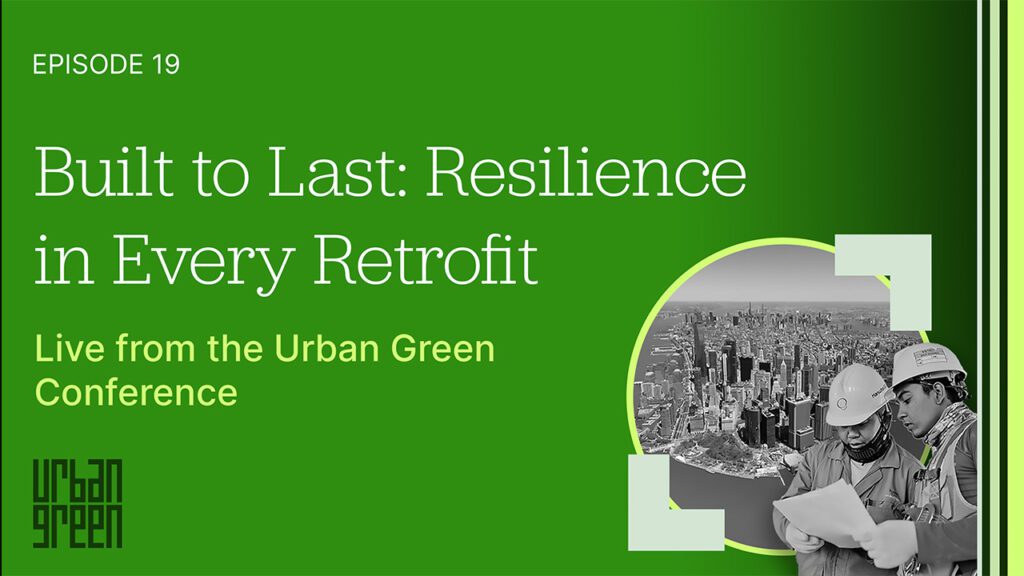
Published August 6, 2025
Live from Urban Green’s 2025 annual conference, this episode of Building Tomorrow features an exciting conversation about how resilience is shaping building design today and how the industry is evolving to meet climate challenges.
Sustainability and resilience are closely linked in the building sector. With more frequent heat waves and extreme storms, New York City’s buildings must be prepared for a changing climate. Decarbonization efforts must integrate resilience to ensure long-term sustainability.
The panel discussion is moderated by Susanne DesRoches, NYSERDA.
Thank you to our lead sponsor, Carrier, for supporting this podcast!

Speakers
Ilana Judah
Arup
Jessica Mederson
Stafford Rosenbaum LLP
Talley Burley
Environmental Defense Fund
Mónika Serrano-Riedlinger
Adaptate LLC
Q&A
Q: How can resilience and decarbonization go hand in hand? When making energy efficiency improvements, what kinds of resilience work can be done at the same time?
Ilana Judah, Arup:
There are a few basic steps we can take:
- Think about designing the building or retrofits for not only today but for the last year it operates. Include future climate scenarios in energy modeling iterations to right-size systems and/or space for future upgrades.
- Undertake a risk assessment to understand potential climate hazard impacts and how they may change over time. This will help inform the appropriate design and help mitigate future damage or downtime.
- Understand co-benefits (e.g., passive strategies) and tradeoffs (sources of backup power) when making design decisions.
- Consider a factor for avoided damage and increased durability when undertaking LCAs and whole life carbon assessments.
Q: In this world, data is crucial! Are there programs/dialog between states to share cost & savings data to further develop resilience for existing buildings?
Talley Burley, Environmental Defense Fund:
- Regarding data:
- Data is important, but many of the data sources that are critical to understand underlying risk and inform resilience are not always public or intuitive to understand unless you’re a climate expert.
- Insurers, for example, typically rely on proprietary data sets that inform their understanding of the climate risks and the impacts of certain resilience interventions when setting insurance rates. We are seeing some states, like California, taking steps to make the models they use public (see public wildfire catastrophe model), and a growing interest in more of this data to be readily available.
- The rollback of federal data sets poses significant challenges. In the private sector—such as for insurance—they may have their own data that is produced, but much of the underlying data comes from robust federal data resourcing and mapping. As more of the federal data is removed, filling that data gap will be an incredibly labor-intensive effort that could take several years.
- States and local governments also rely on this federal data, and under-resourced communities in particular do not have the capacity to create their own data.
- Regarding state collaboration:
- We’ve heard some anecdotal evidence that states are increasingly interested in taking more regional approaches to resilience strategies, particularly in thinking about how climate may impact the insurability of communities, but we haven’t yet seen specific or formal programs emerge
- What we do see is a growing dialogue across states and communities sharing the types of programs and resources they’ve developed to “pay-it-forward” to others as they think about ways to support the resilience retrofits of existing buildings.
- Interesting resources:
- In a recent EDF report published with Cornell that explores ways state insurance markets of last resort are integrating resilience into their programs–through grants, insurance discounts, and riders that provide post-disaster funding for retrofits—our research noted that several states directly mentioned speaking with other states to learn and to share their approach and challenges.
- Check out the recently published report that touches on some of the topics I spoke about during the conference here.
- The EDF economics team also distributes a newsletter once a quarter that highlights newly published reports by the team and speaking engagements—they’ve included this in the list with a link to the recording.
Q: How do you encourage more community-level resiliency? How critical is the social aspect? How much is historic preservation a part of this?
Jessica Mederson, Stafford Rosenbaum LLP:
First, addressing resiliency at the community level, while an absolute must, is challenging, particularly with so many changes at the federal level right now. But one new resource that can be of assistance is Insurance for Good, a non-profit that provides communities with resources and opportunities for collaboration.
Second, anything done at the community level requires a level of social buy-in from that community if it’s going to succeed. From the Ground Up is a great book about local efforts to create resilient cities that can provide lessons and examples to communities looking to strengthen their resilience.
Funding the Future of Decarbonization
Hear about a new concept for a program that would simplify decarbonization projects and drive down costs.
Boosting the Grid with Battery Storage
Hear sustainability experts unpack the benefits of using battery storage to improve the efficiency and reliability of the electrical grid.
NYC Next: Facing down the future
Read our recap of the Urban Green 2025 conference, NYC Next: Shaping Building Decarbonization!